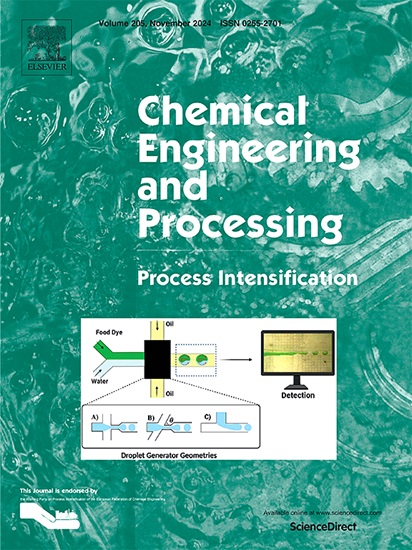Ultrasound-assisted solvent-free synthesis of Citronellyl acetate using Fermase: Kinetics and intensification
IF 3.8
3区 工程技术
Q3 ENERGY & FUELS
Chemical Engineering and Processing - Process Intensification
Pub Date : 2025-05-29
DOI:10.1016/j.cep.2025.110386
引用次数: 0
Abstract
Citronellyl acetate is a flavour ester with a fresh-rosy, fruity smell. It can be synthesized by transesterification reaction of citronellol and vinyl acetate with Fermase as a biocatalyst where vinyl acetate acts as a reactant and a solvent. With advanced process intensification techniques like ultrasound, the maximum conversion can be achieved in reduced reaction time, as concluded by the current study. Under optimized process conditions with a 1:2 mole ratio of citronellol to vinyl acetate, 2 % enzyme loading at 60 °C and 300 RPM agitation speed, using ultrasound power 60 W with 30 % duty cycle at 25 kHz frequency, a maximum citronellol conversion of 99.8 % was achieved within 60 min of reaction time. The enzyme retained 90 % of its activity after six cycles of reuse. Several kinetic models governing the enzymatic reaction were explored, and a modified Ping pong bi-bi model that considered both reactant inhibitions was found to explain the reaction mechanism best. Advanced optimization techniques like the Response Surface Methodology (RSM) were used to compare the results obtained from the one factor at a time method. The ultrasound-assisted method is also compared in detail with the conventional batch stirring method to showcase the process intensification achieved using ultrasound.

超声波辅助发酵酶无溶剂合成醋酸香茅酯:动力学和强化
香茅酰醋酸酯是一种风味酯,具有新鲜的玫瑰色,果香。以发酵酶为生物催化剂,醋酸乙烯作为反应物和溶剂,由香茅醛和醋酸乙烯酯进行酯交换反应合成。正如目前研究得出的结论,利用超声等先进的过程强化技术,可以在缩短的反应时间内实现最大的转化。优化后的工艺条件为:香茅醛与醋酸乙烯酯的摩尔比为1:2,酶载量为2%,搅拌速度为300 RPM,温度为60℃,超声功率为60 W,占空比为30%,频率为25 kHz,反应时间为60 min,香茅醛的转化率最高可达99.8%。这种酶在重复使用6次后仍保持了90%的活性。研究了几种控制酶促反应的动力学模型,发现一个考虑两种反应物抑制的改进乒乓bi-bi模型最能解释反应机理。采用响应面法(RSM)等先进的优化技术对单因素法得到的结果进行比较。并将超声辅助方法与常规间歇搅拌方法进行了详细的比较,以展示超声实现的过程强化。
本文章由计算机程序翻译,如有差异,请以英文原文为准。
求助全文
约1分钟内获得全文
求助全文
来源期刊
CiteScore
7.80
自引率
9.30%
发文量
408
审稿时长
49 days
期刊介绍:
Chemical Engineering and Processing: Process Intensification is intended for practicing researchers in industry and academia, working in the field of Process Engineering and related to the subject of Process Intensification.Articles published in the Journal demonstrate how novel discoveries, developments and theories in the field of Process Engineering and in particular Process Intensification may be used for analysis and design of innovative equipment and processing methods with substantially improved sustainability, efficiency and environmental performance.

 求助内容:
求助内容: 应助结果提醒方式:
应助结果提醒方式:


